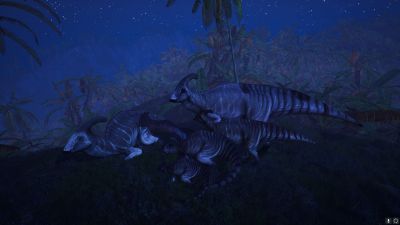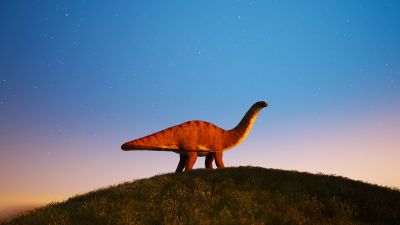Difference between revisions of "Herbivorous Creatures"
m |
|||
| (17 intermediate revisions by 6 users not shown) | |||
| Line 1: | Line 1: | ||
| − | [[File:Ss 6489a3e66932d4b076f51f845bc56d1b95e59780.1920x1080.jpg|right|thumb|400px|A | + | [[File:Ss 6489a3e66932d4b076f51f845bc56d1b95e59780.1920x1080.jpg|right|thumb|400px|A herd of [[Parasaurolophus]] resting for the night.]] |
| − | Herbivorous creatures rely solely on consuming [[Foliage System|plants]] for [[Food|food]]. They are unable to consume [[Fish|fish]] or [[Carcass|meat]]. Beasts of Bermuda currently has | + | [[File:719890 screenshots 20180901191442 1.jpg|right|thumb|400px|border|An [[Apatosaurus]] on a hill]] |
| + | |||
| + | Herbivorous creatures rely solely on consuming [[Foliage System|plants]] for [[Food|food]]. They are unable to consume [[Fish|fish]] or [[Carcass|meat]]. Beasts of Bermuda currently has the following playable, herbivorous creatures: | ||
*[[Apatosaurus]] | *[[Apatosaurus]] | ||
| − | |||
| − | |||
| − | |||
| − | |||
*[[Lurdusaurus]] | *[[Lurdusaurus]] | ||
*[[Oryctodromeus]] | *[[Oryctodromeus]] | ||
| + | *[[Parasaurolophus]] | ||
*[[Saichania]] | *[[Saichania]] | ||
| − | Different herbivores are capable of consuming different | + | Different herbivores are capable of consuming different types of plants. Typically, [[Size|size]] is the factor that determines what plants an herbivorous creature is capable of eating. Each herbivore belongs to a [[Foliage System|foliage class]], which determines, among other things, what plants they can eat. Larger creatures are capable of eating larger plants than smaller herbivores, but in turn, the larger creatures also receive significantly less food value from smaller plants. For this reason, it may be not worth the effort for a large herbivore, such as the [[Apatosaurus]], to consume grass or small bushes, whereas a [[Pachycephalosaurus]] might find these smaller plants enticing. Only the Apatosaurus and very large members of other species, particularly Parasaurolophus, are capable of eating larger foliage such as trees. |
| − | |||
| − | |||
| − | |||
| − | |||
| − | + | Herbivores often harbor more beneficial [[Weather Resistance|weather resistance]] than other [[Terrestrial Creatures|terrestrial creatures]], allowing easier weathering of [[Weather|storms]]. The Apatosaurus in particular is most suited to toughing through bad weather due to its slowness and inability to access many [[Caves|caves]]. | |
| − | Herbivores | + | Herbivores are able to make cross-species [[groups]] with one another and form herds, whereas other creatures are only able to group with their own kind. This grouping system encourages cooperative play when players are herbivores, contrast to the competitive play of [[Carnivorous Creatures|carnivores]]. Players seeking a highly social experience would likely enjoy the herbivorous playstyle. |
| − | + | While other creatures are [[Comfort|stressed]] by the presence of different species, herbivores grant comfort towards one another when in close proximity regardless of being the same or different species. They are also capable of forming cross-species [[Friends and Enemies|friendships]], which is unique only to herbivores. The Apatosaurus in particular grants significant comfort to other nearby herd members. | |
Latest revision as of 08:34, 30 October 2021


Herbivorous creatures rely solely on consuming plants for food. They are unable to consume fish or meat. Beasts of Bermuda currently has the following playable, herbivorous creatures:
Different herbivores are capable of consuming different types of plants. Typically, size is the factor that determines what plants an herbivorous creature is capable of eating. Each herbivore belongs to a foliage class, which determines, among other things, what plants they can eat. Larger creatures are capable of eating larger plants than smaller herbivores, but in turn, the larger creatures also receive significantly less food value from smaller plants. For this reason, it may be not worth the effort for a large herbivore, such as the Apatosaurus, to consume grass or small bushes, whereas a Pachycephalosaurus might find these smaller plants enticing. Only the Apatosaurus and very large members of other species, particularly Parasaurolophus, are capable of eating larger foliage such as trees.
Herbivores often harbor more beneficial weather resistance than other terrestrial creatures, allowing easier weathering of storms. The Apatosaurus in particular is most suited to toughing through bad weather due to its slowness and inability to access many caves.
Herbivores are able to make cross-species groups with one another and form herds, whereas other creatures are only able to group with their own kind. This grouping system encourages cooperative play when players are herbivores, contrast to the competitive play of carnivores. Players seeking a highly social experience would likely enjoy the herbivorous playstyle.
While other creatures are stressed by the presence of different species, herbivores grant comfort towards one another when in close proximity regardless of being the same or different species. They are also capable of forming cross-species friendships, which is unique only to herbivores. The Apatosaurus in particular grants significant comfort to other nearby herd members.